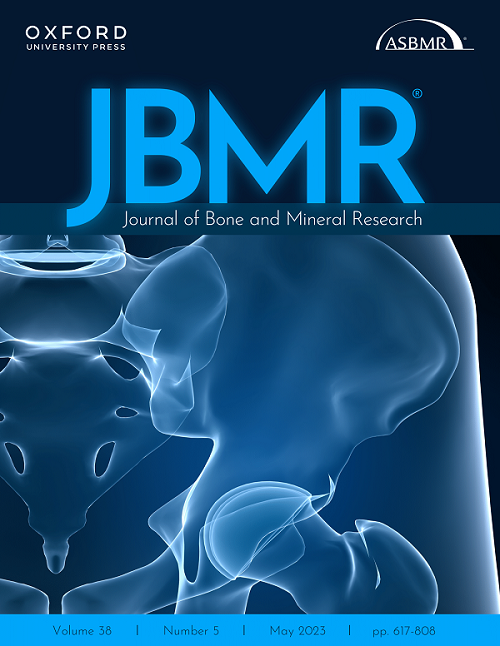Karissa Ludwig, Zenghui Wu, Ghalib Bardai, Patrizia Mason, Leanne M Ward, Pierre Moffatt, Frank Rauch
下载PDF
{"title":"尿源性细胞的RNA测序对成骨不全的特征和诊断","authors":"Karissa Ludwig, Zenghui Wu, Ghalib Bardai, Patrizia Mason, Leanne M Ward, Pierre Moffatt, Frank Rauch","doi":"10.1002/jbmr.4865","DOIUrl":null,"url":null,"abstract":"<p>DNA sequencing is a reliable tool for identifying genetic variants in osteogenesis imperfecta (OI) but cannot always establish pathogenicity, particularly in variants altering splicing. RNA sequencing can provide functional evidence of the effect of a variant on the transcript but requires cells expressing the relevant genes. Here, we used urine-derived cells (UDC) to characterize genetic variants in patients with suspected or confirmed OI and provide evidence on the pathogenicity of variants of uncertain significance (VUS). Urine samples were obtained from 45 children and adolescents; UDC culture was successful in 40 of these participants (age range 4–20 years, 21 females), including 18 participants with OI or suspected OI who had a candidate variant or VUS on DNA sequencing. RNA was extracted from UDC and sequenced on an Illumina NextSeq550 device. Principal component analysis showed that the gene expression profiles of UDC and fibroblasts (based on Genotype Tissue Expression [GTEx] Consortium data) clustered close together and had less variability than those of whole blood cells. Transcript abundance was sufficient for analysis by RNA sequencing (defined as a median gene expression level of ≥10 transcripts per million) for 25 of the 32 bone fragility genes (78%) that were included in our diagnostic DNA sequencing panel. These results were similar to GTEx data for fibroblasts. Abnormal splicing was identified in 7 of the 8 participants with pathogenic or likely pathogenic variants in the splice region or deeper within the intron. Abnormal splicing was also observed in 2 VUS (<i>COL1A1</i> c.2829+5G>A and <i>COL1A2</i> c.693+6T>G), but no splice abnormality was observed in 3 other VUS. Abnormal deletions and duplications could also be observed in UDC transcripts. In conclusion, UDC are suitable for RNA transcript analysis in patients with suspected OI and can provide functional evidence for pathogenicity, in particular of variants affecting splicing. © 2023 The Authors. <i>Journal of Bone and Mineral Research</i> published by Wiley Periodicals LLC on behalf of American Society for Bone and Mineral Research (ASBMR).</p>","PeriodicalId":185,"journal":{"name":"Journal of Bone and Mineral Research","volume":"38 8","pages":"1125-1134"},"PeriodicalIF":5.1000,"publicationDate":"2023-06-09","publicationTypes":"Journal Article","fieldsOfStudy":null,"isOpenAccess":false,"openAccessPdf":"https://onlinelibrary.wiley.com/doi/epdf/10.1002/jbmr.4865","citationCount":"0","resultStr":"{\"title\":\"RNA Sequencing of Urine-Derived Cells for the Characterization and Diagnosis of Osteogenesis Imperfecta\",\"authors\":\"Karissa Ludwig, Zenghui Wu, Ghalib Bardai, Patrizia Mason, Leanne M Ward, Pierre Moffatt, Frank Rauch\",\"doi\":\"10.1002/jbmr.4865\",\"DOIUrl\":null,\"url\":null,\"abstract\":\"<p>DNA sequencing is a reliable tool for identifying genetic variants in osteogenesis imperfecta (OI) but cannot always establish pathogenicity, particularly in variants altering splicing. RNA sequencing can provide functional evidence of the effect of a variant on the transcript but requires cells expressing the relevant genes. Here, we used urine-derived cells (UDC) to characterize genetic variants in patients with suspected or confirmed OI and provide evidence on the pathogenicity of variants of uncertain significance (VUS). Urine samples were obtained from 45 children and adolescents; UDC culture was successful in 40 of these participants (age range 4–20 years, 21 females), including 18 participants with OI or suspected OI who had a candidate variant or VUS on DNA sequencing. RNA was extracted from UDC and sequenced on an Illumina NextSeq550 device. Principal component analysis showed that the gene expression profiles of UDC and fibroblasts (based on Genotype Tissue Expression [GTEx] Consortium data) clustered close together and had less variability than those of whole blood cells. Transcript abundance was sufficient for analysis by RNA sequencing (defined as a median gene expression level of ≥10 transcripts per million) for 25 of the 32 bone fragility genes (78%) that were included in our diagnostic DNA sequencing panel. These results were similar to GTEx data for fibroblasts. Abnormal splicing was identified in 7 of the 8 participants with pathogenic or likely pathogenic variants in the splice region or deeper within the intron. Abnormal splicing was also observed in 2 VUS (<i>COL1A1</i> c.2829+5G>A and <i>COL1A2</i> c.693+6T>G), but no splice abnormality was observed in 3 other VUS. Abnormal deletions and duplications could also be observed in UDC transcripts. In conclusion, UDC are suitable for RNA transcript analysis in patients with suspected OI and can provide functional evidence for pathogenicity, in particular of variants affecting splicing. © 2023 The Authors. <i>Journal of Bone and Mineral Research</i> published by Wiley Periodicals LLC on behalf of American Society for Bone and Mineral Research (ASBMR).</p>\",\"PeriodicalId\":185,\"journal\":{\"name\":\"Journal of Bone and Mineral Research\",\"volume\":\"38 8\",\"pages\":\"1125-1134\"},\"PeriodicalIF\":5.1000,\"publicationDate\":\"2023-06-09\",\"publicationTypes\":\"Journal Article\",\"fieldsOfStudy\":null,\"isOpenAccess\":false,\"openAccessPdf\":\"https://onlinelibrary.wiley.com/doi/epdf/10.1002/jbmr.4865\",\"citationCount\":\"0\",\"resultStr\":null,\"platform\":\"Semanticscholar\",\"paperid\":null,\"PeriodicalName\":\"Journal of Bone and Mineral Research\",\"FirstCategoryId\":\"3\",\"ListUrlMain\":\"https://onlinelibrary.wiley.com/doi/10.1002/jbmr.4865\",\"RegionNum\":1,\"RegionCategory\":\"医学\",\"ArticlePicture\":[],\"TitleCN\":null,\"AbstractTextCN\":null,\"PMCID\":null,\"EPubDate\":\"\",\"PubModel\":\"\",\"JCR\":\"Q1\",\"JCRName\":\"ENDOCRINOLOGY & METABOLISM\",\"Score\":null,\"Total\":0}","platform":"Semanticscholar","paperid":null,"PeriodicalName":"Journal of Bone and Mineral Research","FirstCategoryId":"3","ListUrlMain":"https://onlinelibrary.wiley.com/doi/10.1002/jbmr.4865","RegionNum":1,"RegionCategory":"医学","ArticlePicture":[],"TitleCN":null,"AbstractTextCN":null,"PMCID":null,"EPubDate":"","PubModel":"","JCR":"Q1","JCRName":"ENDOCRINOLOGY & METABOLISM","Score":null,"Total":0}
引用次数: 0
引用
批量引用

 求助内容:
求助内容: 应助结果提醒方式:
应助结果提醒方式:


